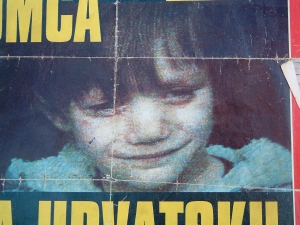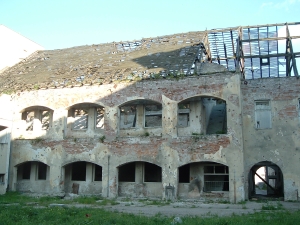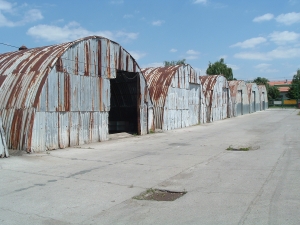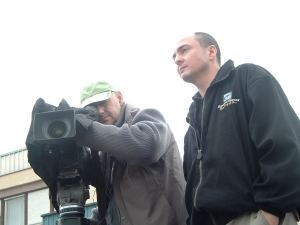
idejaprogramservisengliš |
 |
Vukovar, Final Cut – Vukovar, poslednji rez
Regie: Janko Baljak; 103 Min., SCG/HR 2006 (OmE)
Wettbewerb: Golden Black Box Competition
ACUDkino, So, 19.11.2006 um 18:00 Uhr
babylon berlin:mitte, Mo, 20.11.2006 um 20:15 Uhr
ACUDkino, Do, 23.11.2006 um 18:00 Uhr

A documentary film produced by B92.
This film represents an effort to create a truthful story about everything that happened in Vukovar (Croatia) during the spring, summer and fall of 1991, as well as what happened before this time, shortly after the tragic event of 1991, and what the historical, societal and emotional consequences are, after years of pain, suffering and disappointment. 



We believe that the historical distance of fifteen years is large enough to allow us to make an important, investigative documentary tied to the most painful point of this region.
It is also very important to mention that this is the first Serbian-Croatian co-production about this painful topic, whose wounds have yet to heal, even after fifteen years’ time.
Reporters and investigators from both sides of the Danube River, located in the middle of Europe, and in whose waters’ corpses had floated for nearly a decade, tried to solve the riddle of the true reasons that le up to the great Balkan tragedy.
This is not a film made by outside observers or nonchalant journalists. Nor was it made by war dog reporters who are in the Balkans today, tomorrow in the Near East and in Baghdad the day after; some of us were in the middle of the apocalypse of Vukovar while the city was being torn apart. Some were running from Milosevic’ regime's attempts to make them soldiers of the Yugoslav National Army and mobilizing them to participate in the foolish operations of destroying Vukovar. Others who were independent and crafty were able to, as people and reporters, spend time on both the Serbian and Croatian sides of the front.
We are now, once again, on the same mission, to, with the help of the survivors and available archives, try and put together the pieces of this impossible mosaic. We have created an insider’s story about what actually happened in Vukovar. This is the first objective and propaganda-less film, which is neither a Serbian documentary nor a Croatian one. With no intentions of serving any political causes, this film is more interested in serving the purpose of truth. We are all interest in the story of Vukovar, because it is a part of all of our lives.
We have tried to comprehend why Vukovar, a rich Slavonian town famous for being a "miniature Yugoslavia," Tito's exemplary town of unity, was the one location to suffer total apocalypse, one comparable to the sacrifice and siege of Stalingrad, and by the extent of destruction, and scenes shown around the world, reminiscent of Hiroshima and Nagasaki.
Why was a city which had no strategic interest in military and police force formations in the conflict between the Yugoslav National Army and the Croatian military, so systematically destroyed while the Serbian (Milosevic) and Croatian (Tudjman) leaders walked around Tito’s estate all the while, discussing plans for a new division of Yugoslavia?
The film about Vukovar will be thematically separated into three, connected parts:
• immediately before the war, spring and summer of 1999;
• the siege and defence of Vukovar
• (a film about the film):
• the fall of Vukovar 18.11.1991,
• the Ovcara massacre (more than 200 murdered civilians) and the court process for these war crimes which unfolded in front of the Belgrade Special War Crimes Court.
The investigation included talks with people who made up the destiny of the people at this time, on both sides of the front, and discussions with many people, mostly civilians, who witnessed war-time activity in Vukovar, and who were not in the forefront at the time, but whose eyewitness accounts are very interesting in describing individual situations and events.
The furthest investigations included checking through archives of the most important Croatian media outlets during this period of time: the Vjesnik newspaper documentation (the best in Croatia), HTV’s archive, an archive of local television stations that worked at this time (TV Dunav, TV Baranja, Slavonska television, Vinkovacka television, TV Backa Palanka), and several private archives, amateur video footage taken from Vukovar attics to be used in our film.
Similar investigative work was done in Serbia, where there is still much material and archives of a state that is under an embargo because of Hague indictees, who are deeply involved in the story of this film.
Archival footage used in this film was taken from a number of sources: Zastava film, Film News, Radio Television Croatia, Radio Television Serbia, AP, ITN, Reuters and private footage.
The list of interviewees is also a very long one and includes names such as Marin Vidic Bili, Tomislav Mercep, Dr. Vesna Bosanac, Ferdinad Jukic (Mercep's activities in Vukovar), Zeljka Juric (the little girl in the blue coat from the BBC footage of Vukovar a day after its fall), Branko Borkovic, Croatian volunteer soldier, Martin Spegelj, Ivan Vekic (interior minister in the Government of National Unity), Aleksandar Vasiljevic (a retired Serbian general), Zoran Stankovic (pathologist and current Serbia-Montenegro Defence Minister), Jovan Dulovic and Dejan Anastasijevic and other Vreme magazine journalists, Serbian volunteers and drafted soldiers from the Vukovar battlefield, families of the Ovcara victims and many others.
DIRECTORIAL APPROACH
This is not a simple television report on Vukovar today and fifteen years ago. This is a film where perpetrators of the crimes brought back to the place where the tragedy occurred, sometimes in the same frame.
The camera is an accessory in uncovering this crime, often curious, inquisitive, rude, restless, always in the service of reconstructing the crime, performing its duties as dirtily as the Vukovar war was itself.
Archival material serves as a starting point, an illustration of the story, but it is often a crude means consciously manipulated by the director. It looks for protagonists and witnesses from the archival footage or uncovers the role of the media in the presentation of someone's personal tragedy.
The editorial cut is a fascinating and unflinching means for achieving maximum emotional effect. The style is a direct and merciless cut, The Final Cut, the title of our film. 
